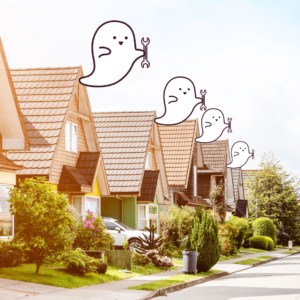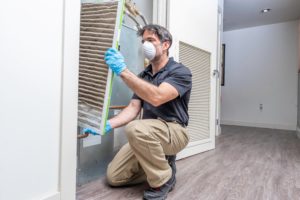Podcast: Play in new window | Download
Summary:
It’s been a year since we had Ray Hespen, co-founder and CEO of PropertyMeld on The Property Management Show podcast to talk about COVID-19 and its impact on property management maintenance.
The last time he was with us, we discussed ghost maintenance – the idea that all these tenants were at home with the pandemic and no one wanted maintenance technicians or vendors in their property. So the theory was that a backlog of unfulfilled maintenance would develop in the early days of the pandemic.
We have him back today to find out if that happened.
Key Takeaways:
- As predicted, maintenance requests in 2020 dropped off in March and April, and then saw a huge uptick beginning in June.
- Maintenance requests in 2021 have stabilized, although Ray has seen a rise in maintenance cost and a rise in the number of requests, which he believes is a result of more folks working remotely from home.
- The rise in maintenance costs is due, in part, to the disruption of the supply chain and the fact that vendors and technicians want to be paid more.
Ghost Maintenance and Rental Properties
 As expected, there was a huge drop off in service requests in the beginning of the pandemic. Then, as vendors and maintenance companies began putting safety protocols in place, the repairs requests began to pick up again.
As expected, there was a huge drop off in service requests in the beginning of the pandemic. Then, as vendors and maintenance companies began putting safety protocols in place, the repairs requests began to pick up again.
The 2020 year was not business as usual in property management.
Ray was on the show last year because he saw a significant reduction in the volume of maintenance requests. Requests began to drop off in March and then in April they were at a complete standstill. In May, people began to feel better about reporting those critical repairs and allowing maintenance teams into their homes. By June, there had been a large backlog created, but there was an increase in work that was being completed.
Through the rest of the year, service professionals were working through that backlog. An equilibrium was reached around October, and more maintenance issues were being generated.
The power of data allowed Ray and his team to make these assumptions, which turned out to be completely accurate.
Property Managers and COVID Maintenance
 Safety protocols for vendors and technicians were a big part of managing maintenance needs during the worst of the pandemic. Property managers were also proactive about soliciting their tenants for any known maintenance needs.
Safety protocols for vendors and technicians were a big part of managing maintenance needs during the worst of the pandemic. Property managers were also proactive about soliciting their tenants for any known maintenance needs.
The concept was that even if the tenants didn’t want someone in the property to fix the problem, property managers still wanted to know there was a problem. The goal was to help tenants feel comfortable submitting the requests.
This was helpful in managing the backlog because once things opened up again, they could prioritize the work needed.
Soliciting maintenance request requires a balance. Property managers don’t want to generate extra costs or invite unnecessary maintenance work for their owners. However, maintaining the property is important, so focusing on those preventative issues and making sure small problems can’t become large problems is important. Property managers understood this. Replacing a leaking toilet can cost thousands of dollars while fixing a gasket is relatively cheap. Property managers serve their owners by paying attention to those things that protect them against larger costs.
Shifting from 2020 Maintenance Trends to 2021
Things are stabilizing in 2021 with maintenance requests. Vaccinations are available and infection rates are not as high. Tenants are generally more open to having people in their homes. The changes that were made in 2020 are still in place. Vendors are mindful of safety protocols and property managers are still soliciting if they’re worried a tenant isn’t reporting necessary maintenance.
Comfort levels have changed, and residents are communicating with their property managers and their maintenance providers about scheduling. It’s systematic and these things will likely stay in place even post-pandemic.
Remote Work and Rental Property Maintenance
 The data shows a couple of interesting points.
The data shows a couple of interesting points.
First, there is a slight uptick in maintenance and service requests overall. These increased maintenance requests are consistent with a culture that’s increasingly working remotely. Residents are in their homes more, so there are going to be more toilet flushes and door handles turned. Statistics show a six percent year over year increase, which is statistically significant.
Second, the invoice costing is up. Rising costs are a big issue for property managers and their clients.
Invoices for maintenance are around 18 percent higher. This is statistically significant and it’s also something property managers need to pay attention to.
Why?
Because an owner will leave a property management company if there’s a perception that maintenance costs are too high. Any property manager will understand that.
Studies show that if annual maintenance costs exceed 10 percent of the rent roll, the likelihood of customer churn goes up significantly.
Invoices that have increased by 18 percent will lead owners to believe they can do it cheaper. They probably can’t – but they don’t know that yet. This is what has property managers most worried.
Explaining the Higher Maintenance Costs
 Lumber prices are maybe 300 percent higher right now than they were 12 months ago. Parts costs more. There have been serious disruptions to the supply chain as well that are driving prices higher and creating a spike in invoice costs.
Lumber prices are maybe 300 percent higher right now than they were 12 months ago. Parts costs more. There have been serious disruptions to the supply chain as well that are driving prices higher and creating a spike in invoice costs.
We’re also seeing vendors and technicians who want to be paid more.
These things have created maintenance costs that are 15 to 22 percent higher than they were a year ago.
As an industry, we should be prepared for these higher prices to stay.
The rental industry is nuts right now. Buying rental units as an individual owner right now is nearly impossible. There’s a ton of institutional money coming into markets all across the country. They’re paying for properties in cash without actually seeing them or requiring an inspection.
There’s also a build-to-rent movement that’s gaining steam. They need plumbers and electricians and construction workers, so the competition for labor is also going to keep prices higher.
Property managers cannot just pass these costs off to the owner because they’ll risk losing business. It’s a big deal, and something we all have to be prepared to deal with going forward.
Maybe a blended maintenance team provides property managers with the lowest cost offering. There are constraints, and smaller companies can’t afford to keep a maintenance professional on staff full-time. Driving down the costs of delivered services will be difficult for property managers who provide value to their owners.
We’ve got more to talk about on this subject, so join us for Part II next time. Before then, always feel free to contact us at Fourandhalf with any questions you might have about The Property Management Show podcast or anything pertaining to property management marketing.

